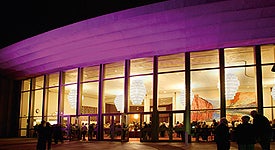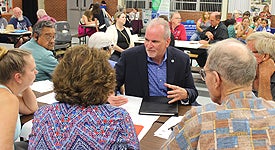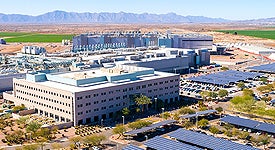Thunderstorms, especially strong storms generated during the annual summer monsoon season, contain several potential dangers to residents of Arizona. In the event that the City of Chandler and surrounding areas experience severe thunderstorms, everyone in the community should be aware of and prepared for the dangers presented by heavy rains, hail, flash flooding, lightning, strong winds and dust storms.
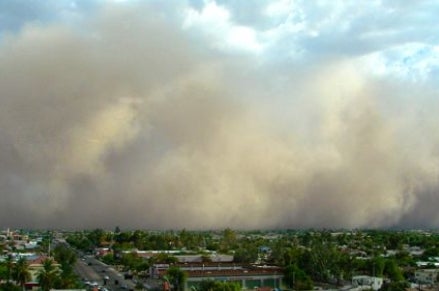
Blowing Dust
Any moderate to severe wind in the arid Sonoran Desert can generate blowing dust that can impair visibility for drivers on Arizona roads and highways.
During the hot summer months, shifting wind patterns can bring enough moisture into the region to cause strong thunderstorms to develop over the mountains and surrounding deserts. These storm systems can produce strong outflow winds that pick up and drive dust ahead of the storm, sometimes forming "walls" of thick dust that rise several thousand feet above the desert floor. Some locals refer to these larger dust storms as haboobs, and while they are visually stunning, they can also be dangerous due to their strong winds and the resulting reduction in visibility.
Everyone who drives in Arizona should know the actions they can take to stay safe if they encounter blowing dust.
Pull Aside, Stay Alive
One of the best resources for learning what to do if you encounter a dust storm is the Arizona Department of Public Safety (ADOT) website, pullasidestayalive.org. All drivers need to know that the most important thing they can do is to not drive into a dust storm. Visibility can very quickly drop to zero, putting everyone in a dangerous situation. If you do encounter a dust storm and you don’t have time to exit the highway, remember these tips (at right):
- Immediately check traffic around your vehicle (front, back and to the side) and begin slowing down.
- Do not wait until poor visibility makes it difficult to safely pull off the roadway – do it as soon as possible. Completely exit the highway if you can.
- Do not stop in a travel lane or in the emergency lane. Look for a safe place to pull completely off the paved portion of the roadway.
- Turn off all vehicle lights, including your emergency flashers. You do not want other vehicles approaching from behind to use your lights as a guide, possibly crashing into your parked vehicle.
- Set your emergency brake and take your foot off the brake.
- Stay in the vehicle with your seatbelts buckled and wait for the storm to pass.
- Drivers of high-profile vehicles should be especially aware of changing weather conditions and travel at reduced speeds.
What To Do When a Storm Approaches
If Indoors
- Secure outdoor objects such as lawn furniture that could blow away or cause damage or injury.
- Shutter windows securely and brace outside doors.
- For power outages, listen to a battery-operated radio or television for the latest storm information. If you have access to cable, Channel 11 may post warnings and other storm-related information as well.
- Telephone lines and metal pipes can conduct electricity. Unplug appliances not necessary for obtaining weather information. Avoid using the telephone or any electrical appliances. Use phones only in an emergency.
- Do not take a bath or shower during the storm. Do not go swimming during a storm.
- Turn off air conditioners. Power surges from lightning can overload the compressors.
If Outdoors
- Find shelter in a building or car. Do not take shelter in small sheds or under isolated trees.
- If you are unable to find shelter, go to a low-lying, open place away from trees, poles, or metal objects and crouch with hands on knees. Do not lie flat on the ground.
- Stay out of pools and away from water.
- Get to higher ground if flash flooding or flooding is possible. Once flooding begins, abandon cars and climb to higher ground. Do not attempt to drive to safety. Note: Most flash flood deaths occur in automobiles.
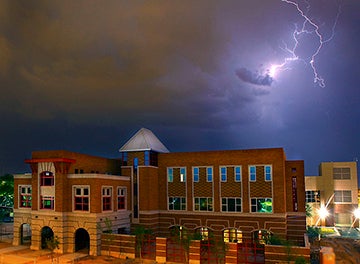
Lightning
- Do not shower during a storm. Lightning can travel through pipes.
- Do not swim during a storm. Lightning can strike bodies of water.
- Lightning can travel through electric lines and damage electronic equipment. Therefore, when practical, unplug the power cords to all electronic equipment to provide total protection from lightning-induced damage.
Safety Tips from SRP:
- Stay at least 100 feet from any downed power line.
- Never try to help someone trapped by a power line. The line could be energized and endanger your own safety. Instead, immediately call 911 for help. Then call SRP's emergency number, 602-236-8811, to report the incident.
- If a power line hits your car while you are in it, stay inside the car until professional help arrives.
- If your vehicle catches fire and you must leave it, avoid making contact with the vehicle and the ground at the same time. Jump from the vehicle, landing with both feet together. Shuffle or hop away, keeping both feet in contact with each other until you are at least 100 feet from the vehicle. This may avoid making your body a ground path between energized and grounded areas or objects.
